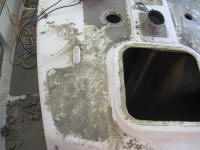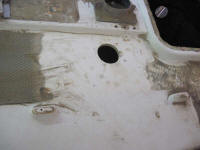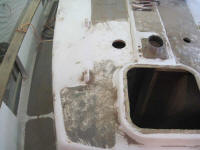Project Log: Saturday, October 23, 2010
Two separate readers contacted me after I posted last
week's log describing my efforts at removing the
Treadmaster from the decks. Both readers suggested
trying one of those famed multi-tools equipped with the
oscillating scraper blade.
I happened to have a less expensive version of the tool
at the shop, a compromise choice I'd acquired earlier
that I felt fit in better with the limited use I
anticipated from the tool. I thought trying this tool
was a worthy suggestion, so I equipped mine with the
appropriate blade, set up an additional extension cord
on deck, and got to work.
With the heat gun in one hand and the multi-tool in the
other, I removed a portion of the Treadmaster from the
forward end of the starboard coachroof. The
process worked, but I'd hoped for a more dramatic
improvement in the ease of removal or a reduction in the
time required. Perhaps it was a bit less physical
work using the oscillating tool than it'd been with the
manual burn-off knife I used earlier, but frankly the
tool was rather heavy and large to use one-handed for an
extended period, and it still required some force to get
the scraper blade beneath the mostly well-stuck
Treadmaster, so it was hardly a relaxing or easy process
despite the mechanism.
After a while, I decided to try one of the wood/metal
cutting blades on the tool, rather than the blunt
scraper attachment. I felt this blade worked a bit
better, but the one I had was duller than I'd have
liked, so I replaced it with a new one from my
inventory. Unfortunately, the new blade--which I
later discovered was a slightly different part number
and was marked as a "wood" blade rather than a
"wood/metal" blade (an error on my part in ordering,
apparently)--lacked the rigidity required, bending under
the pressure of moving the tool forward, so after a few
useless minutes with the newer blade, I switched back to
the more rigid, but dull, wood/metal blade to finish up
the area.
This area required approximately 40 minutes' work,
including blade changes. |
 |
Less than enthralled with the progress, and annoyed at
the loud, buzz-y tool given its generally minimal
positive effect on the process, I decided to try another
tactic: sand off the Treadmaster. I needed
to try it at least as a means of comparison.
Using my usual right angle DA sander equipped with 40
grit discs, I moved on to the next section of the
coachroof. The sander worked, but it took a while
to sand through 1/4" of cork and whatever else is in
Treadmaster, so I tried my small angle grinder equipped
with an angle flap disc, a combination extremely
effective at fast stock removal. Using care, I
removed most of the Treadmaster till I could see the
gray adhesive beneath and no further; I finished up the
sanding with the DA, removing the remaining material
down to the gelcoat so as to avoid the horrific
damage that angle grinders can (and do) do to exterior
surfaces.
This second area, roughly equivalent in size to the
first, required about 20 minutes including a couple
trips down the ladder to fetch the tools and safety
equipment required. The grinding/sanding process
was a mess, of course, but it did have the benefit of
removing the adhesive at the same time, and was clearly
faster, it not necessarily more fun or pleasant. |
 |
However, it's not as if I didn't have significant
sanding to complete on deck anyway; after all, I'd have
to sand all areas as part of the repair and surface prep
required before I could repaint. Clearly, removing
the Treadmaster from this boat was going to be a chore
no matter how I attacked it, so I decided that the path
of least resistance--and the most efficient--would be to
go with the grinder and sander. |
 |
My conclusion: the multi-tool and heat approach
might work well on a removal job where the only goal was
to remove the Treadmaster, not to prepare and repaint
the entire deck areas as required on my boat.
There was certainly the benefit of substantial control
over the process with the electric scraper and heat that
would make it ideal in such an instance. But for
me, in this situation, it was quite clear that the best
way forward would be the grinding/sanding route, despite
the dirtiness of the process and the not-insubstantial
cost of abrasives. But my time was worth more than
abrasives.
Having made this decision, I decided not to proceed with
further Treadmaster removal on this day. Instead,
I started some work in the shop designed to prepare the
more-cluttered-than-I'd-like shop bay for the messy work
ahead. After all, I'd already stripped the
interior of most structures and systems that needed to
come out, and I'd been edging ever closer to the major
surface prep job for both inside and outside the boat.
So, in and around the pleasant distraction of a shop
visit from a friend, I moved what I could out of the
shop, and installed some dust-shedding plastic over some
of the wall shelving and other items in the shop to
minimize the collection of sanding dust on all this
stuff over the coming weeks.
It was just about time for the "bulk sanding" portion of
the project--my term for the necessary evil of getting
the major sanding and surface prep out of the way in one
fell swoop. I looked forward to beginning this
always-satisfying, but dirty, process, completion of
which would signal a milestone and turning point in the
project.
|
Total Time Today: 2.25 hours
|
<
Previous |
Next > |
|
|




